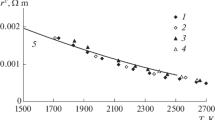Abstract
The electrical resistivity of pyrolytic graphite (PG) deposited at 2300°C decreases in both the a- and c-axis directions as the temperature is increased up to 1000°C, but the high temperature resistivity of PG-bromine residual compounds differ somewhat from that of the original PG. When the temperature is increased, the a-axis resistivity remains nearly constant at the lower temperature range but increases rapidly between 300 and 500°C. Above 500°C the value of the resistivity approaches that of the original PG. On cooling, the change of the electrical resistivity of PG-bromine residual compounds is the same as that on heating, but its value is larger between 500 and 100°C. At room temperature, the a-axis resistivity of the compound before and after the cyclic heat-treatment is the same. This behaviour is closely related to the c-axis thermal expansion and is well explained by the same bromine vaporisation model. As to the c-axis direction, the electrical resistivity of PG-bromine residual compounds show a different behaviour. However, the factors affecting the electrical conduction in this case are complicated and cannot be resolved.
Similar content being viewed by others
References
These compounds are reviewed by several authors such as G. R. Hennig, Progress in Inorganic Chemistry, Interscience, 1 (1959) 125.
A. R. Ubbelohde and F. A. Lewis, “Graphite and It's Crystal Compounds” (Oxford, 1960).
W. Rudorff, Z. anorg. Chem. 245 (1951) 383.
W. T. Eeles and J. A. Turnbull, Proc. Roy. Soc. 283A (1965) 179.
K. Aoki, T. Hirai, and S. Yajima, J. Mater. Sci. 6 (1971) 140.
G. R. Hennig, J. Chem. Phys. 20 (1952) 1438.
Idem, ibid 20 (1952) 1443.
W. H. Martin and J. E. Brocklehurst, Carbon, 1 (1964) 133.
S. Yajima, T. Hirai, and K. Aoki, J. Soc. Mater. Sci. Japan 18 (1969) 1004.
L. C. F. Blackman, J. F. Mathews, and A. R. Ubbelohde, Proc. Roy. Soc. 256A (1960) 15.
L. C. F. Blackman, G. Saunders, and A. R. Ubbelohde, ibid 264A (1961) 19.
G. H. Kinchin, ibid 217A. (1953) 9.
C. A. Klein, Rev. Mod. Phys. 34 (1962) 56.
S. Yajima, T. Hirai, and K. Aoki, Radiat. Eff. 4 (1970) 55.
T. Mukaibo and Y. Takahashi, Bull. Chem. Soc. Japan 36 (1963) 625.
Y. Takahashi, K. Miyauchi, and T. Mukaibo, Tanso, 60 (1970) 8.
Author information
Authors and Affiliations
Rights and permissions
About this article
Cite this article
Aoki, K., Yajima, S. High temperature resistivity of pyrolytic graphite bromine residual compounds. J Mater Sci 6, 1338–1344 (1971). https://doi.org/10.1007/BF00549677
Issue Date:
DOI: https://doi.org/10.1007/BF00549677




